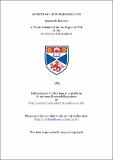Aspects of lipid peroxidation
Abstract
The photosensitised oxidation of the conjugated diene ester methyl octadeca-9E,11E-dienoate gives an unsaturated cyclic peroxide (epidioxide) in high yield. This has been characterised spectroscopically. The 9,12-peroxide undergoes facile rearrangement to the 9,12-furanoid ester under a variety of reaction conditions. Catalytic reduction of the unsaturated peroxide cleaves the O-O bond. Bromination and epoxidation give dibromo and epoxy esters in high yield with the peroxide group still intact. Methyl 9(10)-hydroperoxyoctadec-10(8)E-enoates (1a,b), produced by photosensitised oxidation of methyl oleate are suitable substrates for the synthesis of substituted dioxolanes. Peroxymercuration of (1) affords on hydrogenodemercuration methyl 8,10- and 9,11-epdioxyoctadecanoates (2a,b) in good yield (45-70%). Bromodemercuration yields the corresponding bromo substituted cyclic peroxides (3a,b) in higher yield (95%). Direct bromination of the allylic hydroperoxides (1a,b) also affords the bromo substituted cyclic peroxides (3a,b) in almost quantitative yield, presumably via a bromonium ion intermediate. The photosensitised oxidation of methyl vernolate, ricinoleate, 12-oxooctadec-9Z-enoate and 12-bromooctadec-9Z-enoate leads to allylic hydroperoxides with a shifted double bond as required by the ene-mechanism. The products are thermally sensitive and sample lifetimes are short. The silver trifluoroacetate assisted reaction of alkyl halides with hydrogen peroxide has been investigated. Reaction with methyl 12-bromostearate has furnished for the first time methyl 12-hydroperoxystearate in 34% isolated yield. Reaction with methyl 12-bromooleate, however, is more complicated and leads to the formation of cyclopropane hydroperoxides via a homoallylic cation rearrangement, and to hydroperoxy-epidioxides presumably via methyl 12-hydroperoxyoleate which we were unable to isolate. Methyl 12-t-butylperoxyoleate has been produced by reaction of methyl 12-bromooleate with t-butylhydroperoxide in the presence of silver trifluoroacetate. None of these transformations occur if the silver salt is replaced by silver acetate. 13C nmr chemical shifts are reported for a number of oxygenated long chain aliphatic compounds, including, epoxides alcohols, hydroperoxides and cyclic peroxides. The influence of the oxygenated functional groups on the chemical shifts of neighbouring carbons have been determined and a comprehensive set of chemical shift parameters derived. Results are discussed where applicable in terms of steric and electric field effects.
Type
Thesis, PhD Doctor of Philosophy
Collections
Items in the St Andrews Research Repository are protected by copyright, with all rights reserved, unless otherwise indicated.

